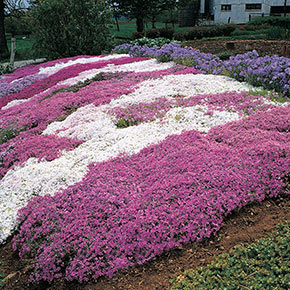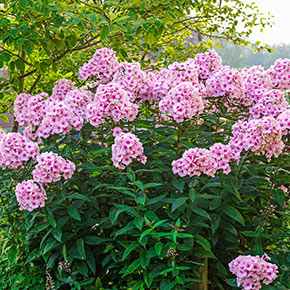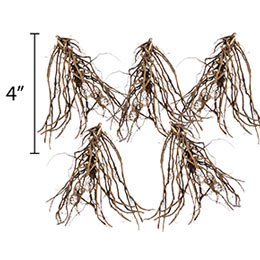
How to Plant, Grow, and Care For Phlox Plants
| Botanical Name |
Phlox subulata |
| Plant Type |
Herbaceous perennial |
| Sun Exposure |
Full sun |
| Soil Type |
Well-drained clay, loamy or sandy soils |
| Soil pH |
Neutral |
| Bloom Time |
Mid to late spring |
| Flower Color |
Pink, purple, white, blue-violet and red |
| Hardiness Zones |
3, 4, 5, 6, 7, 8, 9 |
| Special Features |
Attracts pollinators. Excellent ground cover. |
| Botanical Name |
Phlox paniculata |
| Plant Type |
Herbaceous perennial |
| Sun Exposure |
Full sun to partial shade |
| Soil Type |
Well-drained clay, loamy or sandy soils |
| Soil pH |
Neutral |
| Bloom Time |
Summer to early fall |
| Flower Color |
Pink, purple, white, red, blue-violet, orange |
| Hardiness Zones |
3, 4, 5, 6, 7, 8 |
| Special Features |
Attracts pollinators. Excellent cut flower. |
A must-have for sunny spaces, phlox fills your garden with bright color and sweet fragrance—and this North American native perennial also lures butterflies and other pollinators to the garden. Gardeners grow two major types of phlox—creeping phlox which is grown as a ground cover and blooms in the spring and tall or garden phlox which blooms from summer to early fall. Both types are easy to grow and loved by generations of gardeners. Learn more about how to grow phlox below.
Types of Phlox
Home gardeners grow two main varieties of phlox: creeping phlox (Phlox subulata) and garden phlox (phlox paniculata). Both are low maintenance, native plants with brightly colored, fragrant flowers that attract pollinators. But they have some differences, too.

Creeping Phlox: Also called moss phlox, creeping phlox grows about 6" tall and has a spreading habit. Other characteristics include:
Semi-evergreen, needlelike foliage
Blooms in May and June
Grows best in full sun
Ideal for ground cover, edgings and rock gardens.
Attracts butterflies and insect pollinators

Garden Phlox: Also called tall phlox or flame flowers, garden phlox usually grows 24-36" tall, though newer dwarf varieties are now available. Other characteristics include:
5-6" flowerheads
Blooms from June to September
Grows in full sun to partial shade
Seldom requires staking
Excellent cut flower
Attracts butterflies and hummingbirds
When to Plant Phlox
Phlox can be planted in the spring or the fall. When planting in the spring, wait until danger of spring frost has passed. In the fall, plant transplants at least four weeks before the first fall frost date. This gives the plants time to establish their roots.
Where to Plant Phlox
While both creeping and garden phlox will grow throughout much of the United States, most creeping phlox grows in zones 3-9 while most garden phlox grows in zones 3-8. Find your grow zone using our zone finder.
Phlox grows best in well-drained soil and doesn't like to be waterlogged. Mixing compost into the soil can improve its drainage. While creeping phlox prefers full sun, garden phlox grows best in full sun to partial shade. Garden phlox also needs good air circulation, so avoid overcrowding it in the garden.

How to Plant Phlox Seeds vs. Bare Root
While phlox can spread by seed in the garden, it's easiest to start with potted transplants, bareroot plants or cuttings. To plant phlox, dig a hole deep and wide enough to accommodate the plant's roots. The top of the plant should be even with the soil level. Space plants about 18-24" apart. Because of its spreading nature, creeping phlox is usually spaced about 24" apart, while tall phlox may be spaced 18-20" apart. Water thoroughly after planting.
Materials You'll Need
To plant phlox transplants, you'll need a shovel or trowel for digging. Depending on your soil, phlox may also benefit from Van Bourgondien 100% Natural Perennial Food.
How to Grow Phlox Plants
Once planted, phlox is relatively easy to grow. Phlox has average water needs. While it can handle occasional dry spells, it needs the equivalent of 1" of water weekly during the growing season until its roots are established. A mulch covering helps keep the roots of garden phlox cool and also suppresses weeds and helps the soil retain moisture. Because of its ground-covering qualities, creeping phlox may not be mulched or may be very lightly mulched (watch smothering the tiny leaves).
In warmer climates, garden phlox may benefit from some afternoon shade. Garden phlox usually doesn't require staking. If you plan on staking phlox, then insert the stakes into the ground in the spring before the plants reach their full size.
End of Season Care
Deadheading keeps the plants looking tidy and may promote more blooms. After the first fall frost, cut the stems of garden phlox to about 2" above the ground. Garden phlox may be divided every 3-4 years. Divide the plants in early spring and then replant the divisions.
Phlox FAQs
Is phlox a perennial?
Both garden phlox and creeping phlox are native perennials that return year after year.
Does phlox like sun or shade?
Phlox is a sun-loving perennial. Creeping phlox grows best in full sun, or six or more hours of direct sunlight daily, while garden phlox grows in full sun to partial shade.
How quickly does phlox spread?
Creeping phlox takes a few years to reach maturity. Garden phlox is usually divided every three to four years.
What are common pests and diseases for phlox?
Powdery mildew can be a problem with garden phlox but rarely bothers creeping phlox. Disease resistant phlox varieties are available. Other common pest and disease problems for phlox are spider mites, root rot and foliar nematodes.
Have another question? Return to the Customer Service Help page or send an e-mail directly to Customer Service
 MENU
MENU Plant Finder
Plant Finder
 Help
Help








